Ochre
Ochre (British English) (/ˈoʊkər/ OH-kər; from Ancient Greek: ὤχρα, from ὠχρός, ōkhrós, pale) or ocher (American English)[1] is a natural clay earth pigment which is a mixture of ferric oxide and varying amounts of clay and sand.[2] It ranges in colour from yellow to deep orange or brown. It is also the name of the colours produced by this pigment, especially a light brownish-yellow.[3][4] A variant of ochre containing a large amount of hematite, or dehydrated iron oxide, has a reddish tint known as "red ochre" (or, in some dialects, ruddle).
| Ochre | |
|---|---|
| Hex triplet | #CC7722 |
| sRGBB (r, g, b) | (204, 119, 34) |
| CMYKH (c, m, y, k) | (0, 42, 83, 20) |
| HSV (h, s, v) | (30°, 83%, 80%) |
| Source | [Unsourced] |
| ISCC–NBS descriptor | Deep orange |
| B: Normalized to [0–255] (byte) H: Normalized to [0–100] (hundred) | |
The word ochre also describes clays coloured with iron oxide derived during the extraction of tin and copper.[5]
Earth pigments
Ochre is a family of earth pigments, which includes yellow ochre, red ochre, purple ochre, sienna, and umber. The major ingredient of all the ochres is iron(III) oxide-hydroxide, known as limonite, which gives them a yellow colour.
- Yellow ochre, FeO(OH)·nH
2O, is a hydrated iron hydroxide (limonite) also called gold ochre. - Red ochre, Fe
2O
3, takes its reddish colour from the mineral hematite, which is an anhydrous iron oxide. - Purple ochre is identical to red ochre chemically but of a different hue caused by different light diffraction properties associated with a greater average particle size.
- Brown ochre, also FeO(OH), (goethite), is a partly hydrated iron oxide.
- Sienna contains both limonite and a small amount of manganese oxide (less than 5%), which makes it darker than ochre.
- Umber pigments contain a larger proportion of manganese (5-20%), which makes them a dark brown.[6]
When natural sienna and umber pigments are heated, they are dehydrated and some of the limonite is transformed into hematite, giving them more reddish colours, called burnt sienna and burnt umber. Ochres are non-toxic and can be used to make an oil paint that dries quickly and covers surfaces thoroughly. Modern ochre pigments often are made using synthetic iron oxide. Pigments which use natural ochre pigments indicate it with the name PY-43 (Pigment yellow 43) on the label, following the Colour Index International system.
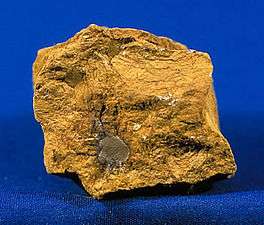 Limonite, a mineraloid containing iron hydroxide, is the main ingredient of all the ochre pigments.
Limonite, a mineraloid containing iron hydroxide, is the main ingredient of all the ochre pigments.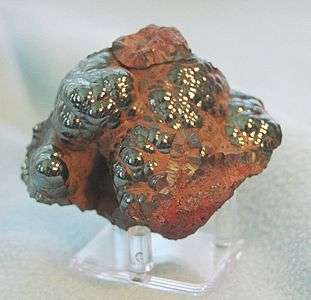 Hematite is a more reddish variety of iron oxide, and is the main ingredient of red ochre. When limonite is roasted, it turns partially to the more reddish hematite and becomes red ochre or burnt sienna.
Hematite is a more reddish variety of iron oxide, and is the main ingredient of red ochre. When limonite is roasted, it turns partially to the more reddish hematite and becomes red ochre or burnt sienna.- The clay hills of Roussillon, Vaucluse, in Provence have been an important source of ochre pigment since the 18th century.
Historical use in art and culture
Prehistory
The use of ochre is particularly intensive: it is not unusual to find a layer of the cave floor impregnated with a purplish red to a depth of eight inches. The size of these ochre deposits raises a problem not yet solved. The colouring is so intense that practically all the loose ground seems to consist of ochre. One can imagine that the Aurignacians regularly painted their bodies red, dyed their animal skins, coated their weapons, and sprinkled the ground of their dwellings, and that a paste of ochre was used for decorative purposes in every phase of their domestic life. We must assume no less, if we are to account for the veritable mines of ochre on which some of them lived...
Iron oxide is one of the most common minerals found on earth, and there is much evidence that yellow and red ochre pigment was used in prehistoric and ancient times by many different civilizations on different continents. Pieces of ochre engraved with abstract designs have been found at the site of the Blombos Cave in South Africa, dated to around 75,000 years ago.[7]
The practice of ochre painting has been prevalent among Indigenous Australian people for over 40,000 years. Pleistocene burials with red ochre date as early as 40,000 BP and ochre plays a role in expressing symbolic ideologies of the earliest arrivals to the continent.[8]
In Wales, the paleolithic burial called the Red Lady of Paviland from its coating of red ochre has been dated to around 33,000 years before present. Paintings of animals made with red and yellow ochre pigments have been found in paleolithic sites at Pech Merle in France (ca. 25,000 years old), and the cave of Altamira in Spain (ca. 16,500–15,000 BC). The cave of Lascaux has an image of a horse coloured with yellow ochre estimated to be 17,300 years old.
Ochre has uses other than as paint: "tribal peoples alive today . . . use either as a way to treat animal skins or else as an insect repellent, to staunch bleeding, or as protection from the sun. Ochre may have been the first medicament." [9] According to some scholars, Neolithic burials used red ochre pigments symbolically, either to represent a return to the earth or possibly as a form of ritual rebirth, in which the colour symbolises blood and the Great Goddess.[10]
The Ancient Picts were said to paint themselves "Iron Red" according to the Gothic historian Jordanes. Frequent references in Irish myth to "red men" (Gaelic: Fer Dearg) make it likely that such a practice was common to the Celts of the British Isles, bog iron being particularly abundant in the midlands of Ireland.
Researchers diving into dark submerged caves on Mexico’s Yucatan Peninsula have found evidence of an ambitious mining operation starting 12,000 years ago and lasting two millennia for red ochre.[11]
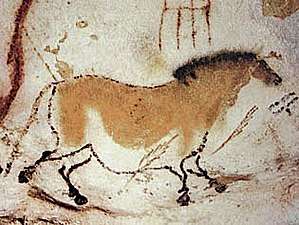 Image of a horse coloured with yellow ochre (17,300 BC) from Lascaux cave, France.
Image of a horse coloured with yellow ochre (17,300 BC) from Lascaux cave, France. Image of a human hand created with red ochre in Pech Merle cave, France (Gravettian era, 25,000 BC).
Image of a human hand created with red ochre in Pech Merle cave, France (Gravettian era, 25,000 BC).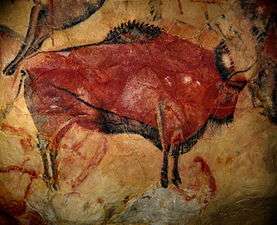 Image of a bison from the cave of Altamira in Spain, painted with red ochre between 16,500 and 15,000 BC.
Image of a bison from the cave of Altamira in Spain, painted with red ochre between 16,500 and 15,000 BC.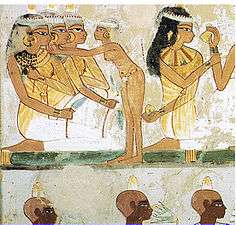 Paintings in the Tomb of Nakht in ancient Egypt (15th century BC).
Paintings in the Tomb of Nakht in ancient Egypt (15th century BC).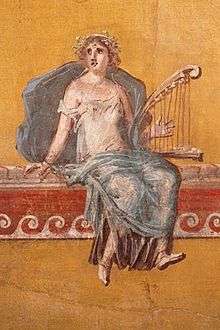 Yellow ochre was often used in wall paintings in Ancient Roman villas and towns.
Yellow ochre was often used in wall paintings in Ancient Roman villas and towns.
Greece and Rome
Ochre was the most commonly used pigment for painting walls in the ancient Mediterranean world. In Ancient Greece, red ochre was called μίλτος, míltos (hence Miltiades, red-haired or ruddy). In Athens when Assembly was called, a contingent of public slaves would sweep the open space of the Agora with ropes dipped in miltos: those citizens that loitered there instead of moving to the Assembly area would risk having their clothes stained with the paint. This prevented them from wearing these clothes in public again, as failure to attend the Assembly incurred a fine. It was also known as "raddle", "reddle" or "ruddle"[12] and was used to mark sheep and can also be used as a waxy waterproof coating on structures. The reddle was sold as a ready-made mixture to farmers and herders by travelling workers called reddlemen.[13] A reddleman named Diggory Venn was prominently described in Thomas Hardy's 1878 novel entitled The Return of the Native.
In classical antiquity, the finest red ochre came from a Greek colony on the Black Sea where the modern city of Sinop in Turkey is located. It was carefully regulated, expensive and marked by a special seal, and this colour was called sealed Sinope. Later the Latin and Italian name sinopia was given to wide range of dark red ochre pigments.[14] Roman triumphators painted their faces red, perhaps to imitate the red-painted flesh of statues of the Gods.[15] The Romans used yellow ochre in their paintings to represent gold and skin tones, and as a background colour. It is found frequently in the murals of Pompeii.
Egypt
In Ancient Egypt, yellow was associated with gold, which was considered to be eternal and indestructible. The skin and bones of the gods were believed to be made of gold. The Egyptians used yellow ochre extensively in tomb painting, though occasionally they used orpiment, which made a brilliant colour, but was highly toxic, since it was made with arsenic. In tomb paintings, men were always shown with brown faces, women with yellow ochre or gold faces.[16]
Red ochre in Ancient Egypt was used as a rouge, or lip gloss for women.[17] Ochre-coloured lines were also discovered on the Unfinished Obelisk at the northern region of the Aswan Stone Quarry, marking work sites. Ochre clays were also used medicinally in Ancient Egypt: such use is described in the Ebers Papyrus from Egypt, dating to about 1550 BC.
Australia
Ochre has been used for millennia by Aboriginal Australians for body decoration, sun protection,[18] mortuary practices, cave painting, bark painting and other artwork, and the preservation of animal skins, among other uses. At Lake Mungo, in Western New South Wales, burial sites have been excavated and burial materials, including ochre-painted bones, have been dated to the arrival of people in Australia;[19] "Mungo Man" (LM3) was buried sprinkled with red ochre at dates confidently estimated as at least 30,000 years B.P. and possibly as old as 60,000 years old.[20] Ochre pigments are plentiful across Australia, especially the Western Desert, Kimberley and Arnhem Land regions, and occur in many archaeological sites.[21]
The National Museum of Australia has a large collection of samples of ochre from many sites across Australia.[22]
New Zealand
The Māori people of New Zealand were found to be making extensive use of mineral ochre mixed with fish oil.[23] Ochre was the predominant colouring agent used by Maori, and was used to paint their large waka taua (war canoe). Ochre prevented the drying out of the wood in canoes and the carvings of meeting houses; later missionaries estimated that it would last for 30 years. It was also roughly smeared over the face, especially by women, to keep off insects. Solid chunks of ochre were ground on a flat but rough surfaced rock to produce the powder.
North America
In Newfoundland[24] its use is most often associated with the Beothuk, whose use of red ochre led them to be referred to as "Red Indians" by the first Europeans to Newfoundland.[25] The Beothuk may have also used yellow ochre to colour their hair. [26] It was also used by the Maritime Archaic as evidenced by its discovery in the graves of over 100 individuals during an archaeological excavation at Port au Choix. Its use was widespread at times in the Eastern Woodlands cultural area of Canada and the US; the Red Ocher people complex refers to a specific archaeological period in the Woodlands ca. 1000–400 BC. California Native Americans such as the Tongva and Chumash were also known to use red ochre as body paint.[27]
In Newfoundland, red ochre was the pigment of choice for use in vernacular outbuildings and work buildings associated with the cod fishery. Deposits of ochre are found throughout Newfoundland, notably near Fortune Harbour and at Ochre Pit Cove. While earliest settlers may have used locally collected ochre, people were later able to purchase pre-ground ochre through local merchants, largely imported from England.
The dry ingredient, ochre, was mixed with some type of liquid raw material to create a rough paint. The liquid material was usually seal oil or cod liver oil in Newfoundland and Labrador, while Scandinavian recipes sometimes called for linseed oil. Red ochre paint was sometimes prepared months in advance and allowed to sit, and the smell of ochre paint being prepared is still remembered today.[28]
Variations in local recipes, shades of ore, and type of oil used resulted in regional variations in colour. Because of this, it is difficult to pinpoint an exact shade or hue of red that would be considered the traditional "fishing stage red". In the Bonavista Bay area one man maintained that seal oil mixed with the ochre gave the sails a purer red colour, while cod liver oil would give a "foxy" colour, browner in hue.[29]
Africa

Red ochre has been used as a colouring agent in Africa for over 200,000 years.[30] Women of the Himba ethnic group in Namibia use a mix of ochre and animal fat for body decoration, to achieve a reddish skin colour. The ochre mixture is also applied to their hair after braiding.[31] Men and women of the Maasai people in Kenya and Tanzania have also used ochre in the same way.
Renaissance
During the Renaissance, yellow and red ochre pigments were widely used in painting panels and frescoes. The colours vary greatly from region to region, depending upon whether the local clay was richer in yellowish limonite or reddish hematite. The red earth from Pozzuoli near Naples was a salmon pink, while the pigment from Tuscany contained manganese, making it a darker reddish brown called terra di siena, or sienna earth.[32]
The 15th-century painter Cennino Cennini described the uses of ochre pigments in his famous treatise on painting.
This pigment is found in the earth of mountains, where particular seams like sulphur are found. And there, where these seams are, sinopia, green earth and other types of pigment are found...And the abovementioned pigments running through this landscape looked as a scar on the face of a man or of a woman looks...I went in behind with my little knife, prospecting at the scar of this pigment; and in this way, I promise you, I never sampled a more lovely and perfect ochre pigment...And know that this ochre is a common pigment, particularly when working in fresco; that with other mixtures that, as i will explain to you, it is used for flesh colours, for drapery, for coloured mountains and buildings and hair and in general for many things.[33]
In early modern Malta, red ochre paint was commonly used on public buildings.[34]
Modern history
The industrial process for making ochre pigment was developed by the French scientist Jean-Étienne Astier in the 1780s. He was from Roussillon in the Vaucluse department of Provence, and he was fascinated by the cliffs of red and yellow clay in the region. He invented a process to make the pigment on a large scale. First the clay was extracted from open pits or mines. The raw clay contained about 10 to 20 percent ochre. Then he washed the clay to separate the grains of sand from the particles of ochre. The remaining mixture was then decanted in large basins, to further separate the ochre from the sand. The water was then drained, and the ochre was dried, cut into bricks, crushed, sifted, and then classified by colour and quality. The best quality was reserved for artists' pigments.[6]
In Britain, ochre was mined at Brixham England. It became an important product for the British fishing industry, where it was combined with oil and used to coat sails to protect them from seawater, giving them a reddish colour. The ochre was boiled in great caldrons, together with tar, tallow and oak bark, the last ingredient giving the name of barking yards to the places where the hot mixture was painted on to the sails, which were then hung up to dry. In 1894, a theft case provided insights into the use of the pigment as a food adulterant in sausage roll production whereby the accused apprentice was taught to soak brown bread in red ochre, salt, and pepper to give the appearance of beef sausage for the filling.[35]
As noted above, the industrial process for making ochre pigment was developed by the French scientist Jean-Étienne Astier in the 1780s, using the ochre mines and quarries in Roussillon, Rustrel, or Gargas in the Vaucluse department of Provence, in France. Thanks to the process invented by Astier and refined by his successors, ochre pigments from Vaucluse were exported across Europe and around the world. It was not only used for artists paints and house paints; it also became an important ingredient for the early rubber industry.
Ochre from Vaucluse was an important French export until the mid-20th century, when major markets were lost due to the Russian Revolution and the Spanish Civil War. Ochre also began to face growing competition from newly synthetic pigment industry. The quarries in Roussillon, Rustrel, the Mines of Bruoux closed one by one. Today, the last quarry in activity is in Gargas (Vaucluse) and belongs to the Société des Ocres de France.
In heraldry
Ochre, both red and yellow, appear as tinctures in South African heraldry; the national coat of arms, adopted in 2000, includes red ochre, while (yellow) ochre appears in the arms of the University of Transkei.[36][37]
See also
- Clay earth pigment
- Falu red
- Female cosmetic coalitions
- Iron(III) oxide
- List of colors
- List of inorganic pigments
- Red Lady of Paviland
References
- See American and British English spelling differences#-re, -er)
- ocher. American Heritage Dictionary. 1969.
- Shorter Oxford English Dictionary (2002), Oxford University Press.
- The Random House College Dictionary, Revised Edition, (1980). "Any of a class of natural earths, mixtures of hydrated oxides of iron and various earthy materials, ranging in colour from pale yellow to orange and red, and used as pigments. A colour ranging from pale yellow to reddish-yellow."
- "Ochre". Collier's New Encyclopedia. 1921.
- Roelofs, Isabelle (2012). La couleur expliquée aux artistes. Groupe Eyrolles. ISBN 978-2-212-134865. p. 30
- Wilford, John Noble (October 13, 2011). "African Cave Yields Evidence of a Prehistoric Paint Factory" – via NYTimes.com.
- Hiscock, Peter (2007-12-12). Archaeology of Ancient Australia. Routledge. p. 125. ISBN 978-1-134-30440-0.
- Watson, Peter (2006). Ideas : a history from fire to Freud (Pbk. ed.). London: Phoenix. p. 38. ISBN 0-7538-2089-7. OCLC 65468616.
- Giulia Battiti Sorlini, "The Megalithic Temples of Malta", Por Anthony Bonanno, Archaeology and fertility cult in the ancient Mediterranean: papers presented at the First International Conference on Archaeology of the Ancient Mediterranean, University of Malta, 2–5 September 1985, p.145.
- https://www.reuters.com/article/us-science-caves/prehistoric-ochre-mining-operation-found-in-submerged-mexican-caves-idUSKBN2442EM
- Mercer, Henry C. (2000). Ancient carpenters' tools illustrated and explained, together with the implements of the lumberman, joiner, and cabinet-maker in use in the eighteenth century (Dover ed.). Mineola, N.Y.: Dover Publications. p. 308. ISBN 978-0486320212.
- Morris, David (2013). Shepherds' Huts & Living Vans. Amberley Publishing Limited. ISBN 978-1445621418. Retrieved 24 November 2014.
- Thompson, Daniel V. (2012-05-11). The Materials and Techniques of Medieval Painting. Courier Corporation. p. 98. ISBN 978-0-486-14203-6.
- "The Roman Triumph | David Frum". davidfrum.com.
- "Pigments through the Ages - Antiquity". www.webexhibits.org.
- Hamilton R. (2007). Ancient Egypt: The Kingdom of the Pharaohs. Parragon Inc. p. 62.
- Rurenga, Declan (2017-08-09). "Wiradjuri artist's painting depicts journey of healing at hospital". Central Western Daily. Retrieved 2018-05-13.
- "Lake Mungo 3". Personal.une.edu.au. Archived from the original on 2014-01-26. Retrieved 2012-12-27.
- Bowler JM, Johnston H, Olley JM, Prescott JR, Roberts RG, Shawcross W, Spooner NA (2003). "New ages for human occupation and climatic change at Lake Mungo, Australia". Nature. 421 (6295): 837–40. Bibcode:2003Natur.421..837B. doi:10.1038/nature01383. PMID 12594511.
- "Aboriginal Art Online, Traditional painting methods". Aboriginalartonline.com. Archived from the original on 22 April 2011. Retrieved 2012-12-27.
- "Ochre samples, National Museum of Australia". Nma.gov.au. Retrieved 2012-12-27.
- Dieffenbach cited in Wells, B., 1878. The history of Taranaki. Edmondson and Avery, New Plymouth.
- "Red ochre in Newfoundland". Fisheriesheritage.ca. 2006-09-24. Archived from the original on 2016-08-22. Retrieved 2012-12-27.
- Ingeborg Marshall, The Beothuk of Newfoundland: A Vanished People, Breakwater Books, 1989, p.5.
- Gilbert, William (February 2009). "The Baccalieu Trail Archaeology Project 2008: A Preliminary Report on Excavations at Cupids and Dildo Island" (PDF). Provincial Archaeology Office 2008 Archaeology Review. 7: 58–66.
- The Megalithic Portal and Megalith Map. "C. Michael Hogan, Los Osos Back Bay, Megalithic Portal, editor A. Burnham (2008)". Megalithic.co.uk. Retrieved 2012-12-27.
- Jarvis, Dale Gilbert; Barrett, Terra M. (March 2019). "The Historical Use of Ochre Pigments in Newfoundland and Labrador" (PDF). Heritage Foundation. Retrieved 3 January 2020.
- Jarvis, Dale Gilbert; Barrett, Terra M. (March 2009). "The Historical Use of Ochre Pigments in Newfoundland and Labrador" (PDF). Heritage Foundation. Retrieved 4 January 2020.
- Mcbrearty, Sally; Brooks, Alison S. (2000-11-01). "The revolution that wasn't: a new interpretation of the origin of modern human behavior". Journal of Human Evolution. 39 (5): 453–563. doi:10.1006/jhev.2000.0435. PMID 11102266.
- Crandall, David P. (2000). The Place of Stunted Ironwood Trees. New York: Continuum International Publishing Group Inc. p. 48
- Daniel V. Thompson, The Materials and Techniques of Medieval Painting, p. 99
- Lara Broecke, Cennino Cennini's Il Libro dell'Arte: a New English Translation and Commentary with Italian transcription, Archetype 2015, p. 71
- "Auberge D'Aragon" (PDF). National Inventory of the Cultural Property of the Maltese Islands. 28 December 2012. Archived from the original (PDF) on 3 March 2016.
- The Times, Police, 5 February 1894; pg. 14
- "South Africa – Coat of Arms". Crwflags.com. Retrieved 2009-04-16.
- Mike Oettle. "Armoria academica - University of Transkei". geocities.com/wapenskild. Archived from the original on June 3, 2004.
Sources
- Helwig, K. Iron Oxide Pigments, in Artists’ Pigments, Berrie, B.H., Ed., National Gallery of Art Washington, 2007, pp. 38–109.
- Isabelle Roelofs and Fabien Petillion, La couleur expliquée aux artistes, Editions Eyrolles, (2012), ISBN 978-2-212-13486-5.
- Philip Ball, Histoire vivante des couleurs (2001), Hazan Publishers, Paris, ISBN 978-2-754105-033.
- Fuller, Carl; "Natural Colored Iron Oxide Pigments", pp. 281–6. In: Pigment Handbook, 2nd Edition. Lewis, P. (ed.). New York: John Wiley & Sons, 1988.
- Thomas, Anne Wall. Colors From the Earth, New York: Van Nostrand Reinhold, 1980.
- Wreschner, Ernst E. (October 1980) "Red Ochre and Human Evolution: A Case for Discussion." Current Anthropology 21:631–644. (Comments by various authors included.)
- Daniel V. Thompson (1956), The Materials and Techniques of Medieval Painting, Dover Publications, New York. ISBN 0-486-20327-1.
- Lara Broecke, Cennino Cennini's Il Libro dell'Arte: a New English Translation and Commentary with Italian Transcription, Archetype, London, 2015, ISBN 978-1-909492-28-8.
- David Bomford and Ashoka Roy (2009), A Closer Look- Colour, The National Gallery, London, ISBN 978-1-85709-442-8.
External links
| Wikisource has the text of the 1921 Collier's Encyclopedia article Ochre. |
| Wikimedia Commons has media related to Ochre. |
- Pigments through the ages
- A recipe for red ochre paint.
- Aboriginal Art Online Use of ochres in traditional Aboriginal art.
- National Museum of Australia Collection of ochre samples.
- Yellow ochre, Colourlex
- Red ochre, Colourlex
- Earth Pigments